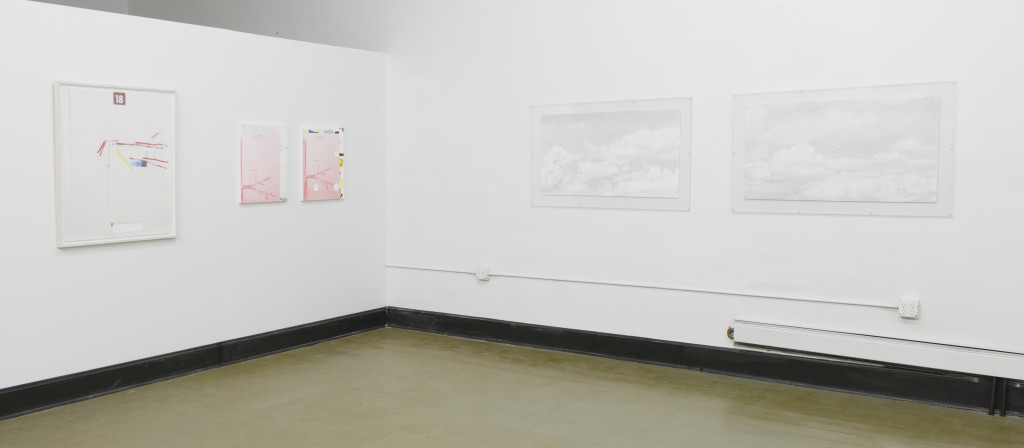Dan Devening: Triumph Gallery
by Ruslana Lichtzier
Partly loose, partly calculated, Dan Devening’s works operate within a bare economic circuit, where paintings become “scavengers” (the artist’s terms). You may notice a photographic, bureaucratic remanence; an image of a wall, a lobby, a notebook, some paper schreds. Hiding, obscuring the scene, the works push your gaze to the edges, or beyond the foreground. This does not reveal a thing. It is not about a story. The paint, the marks, the studio movement traces, decoy your body through a play of balances—to an unavoidable pleasure. It is a perverse experience, of slippages, as its form shifts away from you. Devening spoke with curators Ruslana Lichtzier and Ryan Coffey, as part of his inclusion in the exhibition entitled DOOR, which took place at Triumph in Chicago. A transcription of the conversation is below.
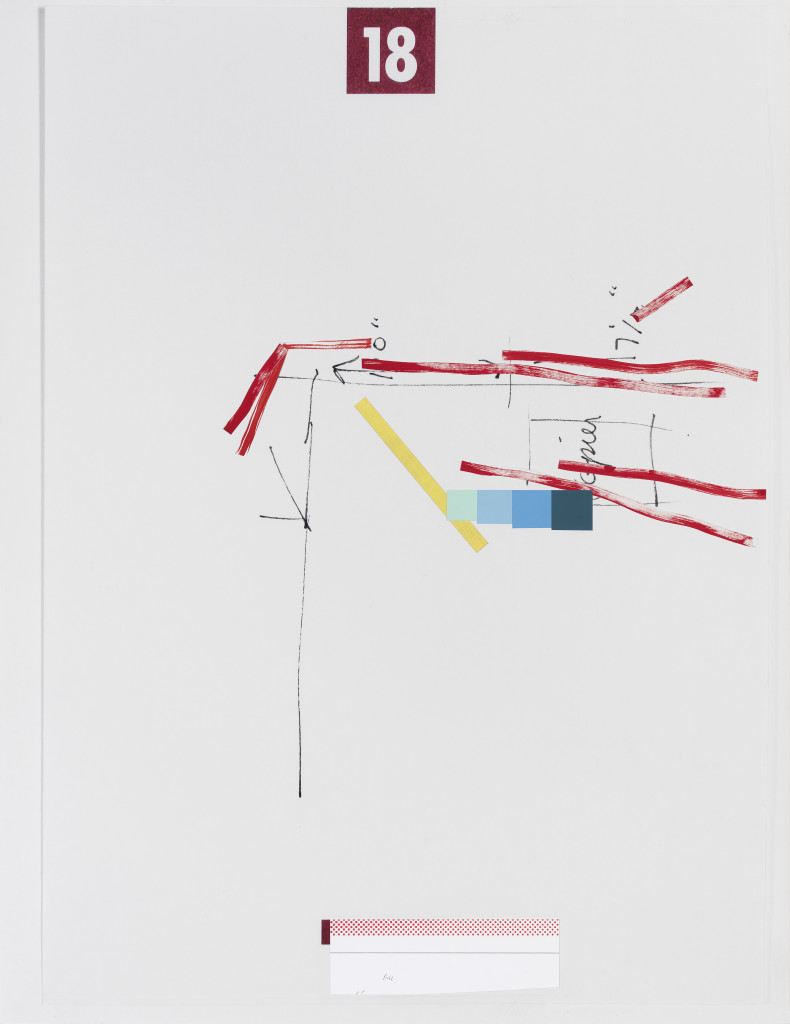
RYAN COFFEY: You have a long relationship exhibiting in Germany. Do you feel your work translates better there? Or differently?
DAN DEVENING: I am not sure my work translates any better or worse in Germany than here, but I think there is a strong interest in the painting “conversation” that provides an engaged and willing audience. You can find a strong interest in Formalism in particular there, so as a painter equally engaged with formal concerns, I like the experiences I’ve had around painting/painting history, etc. In fact, there are artists I know in Germany who have spent their entire lives on a very specific painting problem. They literally hammer that out until it is fully clear; absolutely resolved. That sort of intensity unnerves me a little bit; that type of obsessive purpose. I am somewhere between that and a more open-ended, informal approach to making work. I think my life has changed a lot over the years, I mean my entire life shifted considerably since early 2000, late 90s. I think the work is reflecting that shift of focus and energy.
RC: Can you elaborate?
DD: I was spending a significant amount of time—for years—just going to my studio and teaching. My social life was limited to a few close friends. At some point, I realized I had to change my way of engaging with the world, especially the art world. So, I started curating exhibitions and began working on, what I considered to be some ambitious curatorial projects. I developed conversations with artists that were less about my work but about themes that we both found interesting and worth pursuing. As the curation evolved into the gallery, it was more about me trying to fuse my interest in presentation, curation, and notions of site specificity with artists that I thought were doing very interesting things. In my own work, I began to fold in the idea of presentation into my own objects, or display things. It was necessary to find the links between the various facets of my life. It’s not easy to run a gallery, be a practicing artist and teach a full-time load. Something inevitably suffers or possibly really succeeds. I decided I really wanted the work to kind of express more, what I’m interested in, in terms of this notion of presentation and experiencing the object spatially. Before this, my paintings were much more precise through a dedicated and focused process and execution. The paintings got tighter and tighter, the air started to leave the work. A lot of this collage/assemblage stuff is coming out of that experience, trying to relax the process and be more in the moment of making.
RC: I ask because it related to my own practice. In a sense, I am a strict formalist, but there is a lot of me coming out in the last year. It is much more on the conceptual side, and less about me making marks and doing things…have you had any sort of crisis of confidence in terms of doing formal work? Or have you always been like this?
DD: I would prefer not to define the work specifically as formal or conceptual. I realize that because I became more involved with developing the gallery while staying involved with my studio, it did not fall into one category or the other. The work and the gallery bleeding into one another. So, I never had a crisis. For me, the work and the gallery are also about audience engagement, opticality and physical experience. It’s about providing a type of a thing that rewards and challenges the viewer. I love the idea of close looking and what it provides, even early on I was obsessed stupid little details like how the edge of one thing in the work meets another. When you got up close, it needed to be super fine and perfect. That is how I look at art, I want to look at it from distance, then look at it up close. The work should offer different experiences at various proximities. I do not want to be disappointed if I get up close and it comes up short…So, for me the work is very much about looking, perception and opticality.
RUSLANA LICHTZIER: The political aspects of painting are kind of vacuumed out today, because of a very limited conversation about what is political. That is why I enjoy how you talk about opticality, because for me this is political. Understanding how your body operates in space and understanding perception and the illusion-ness and the reality of perception and how transient the whole thing is. This is a real encounter in the world and that has political potential.
DD: Sure, my work never went that far into it, but I love the possibility of it being interpreted that way. It is not my intention to direct the content to that extreme, but I do think you are absolutely right. I totally agree that there is weight in the work, a sort of relation of the body in motion to the thing we look at, and how we move through the world, and how it changes or directs us. I am a true believer in the pleasure of an artwork, but I’m also interested in subverting that feeling of satisfaction at various levels as well. I don’t know if this is interesting to you, but I would like to show you this piece, because historically it is important to me. This is a recent painting by Gary Stephan who is an artist that I show in the gallery. Gary is an artist I knew about in the 80s; he was showing at Mary Boone, he was part of that Julian Schnabel, Ross Buckner, David Salle crew, that all came up at the same time, and were recognized for somehow returning painting the conversation about contemporary art. Just to set the stage, when I was in grad school at UIC in the early 80s, we had a run of terrible visiting artists. Very dry and very boring. As a group of young artists who were interested in actually making things, these dry theorists didn’t seem to serve us at all. So, the department gave me the visiting artists budget. I had the phone numbers of all these artists in New York, you could just call information and they would give you the number of all these painters I was totally into. The visiting artist series quickly became a series that featured artists, that I liked and was curious to hear them speak about their work. The 80s was an interesting time for painting
RL: This is amazing, you just pick up the phone.
DD: Exactly! I talked to all of these people. Some did not want to come for $300 and pay for their own flight…I don’t know why! So I called Gary Stephan. He was one of the few people who flew to Chicago gave a lecture and spoke to grad students for that tiny stipend. As a painter, I’ve always been interested in his relationship to abstraction, materiality and visuality. Now I’m showing him in the gallery, I work beside him. It’s kind of a huge deal for me. We even showed together in Germany last summer. He’s continuing to produce amazing work in his studio… I think a lot of my interest in form and opticality came out of my relationship to his work. And I think what you said about the politics of visuality and stuff, it’s interesting because he is a painter who is a pure formalist but a formalist whose content is driven by how form is meaning. Curiously, he doesn’t care so much about the sensations produced by the work. He’s not trying to make a sexy painting. Once the painting does its thing, fulfills its objective, the work is done, as he says, “I don’t need to do anything else to it, I just want to move on to the next painting.”
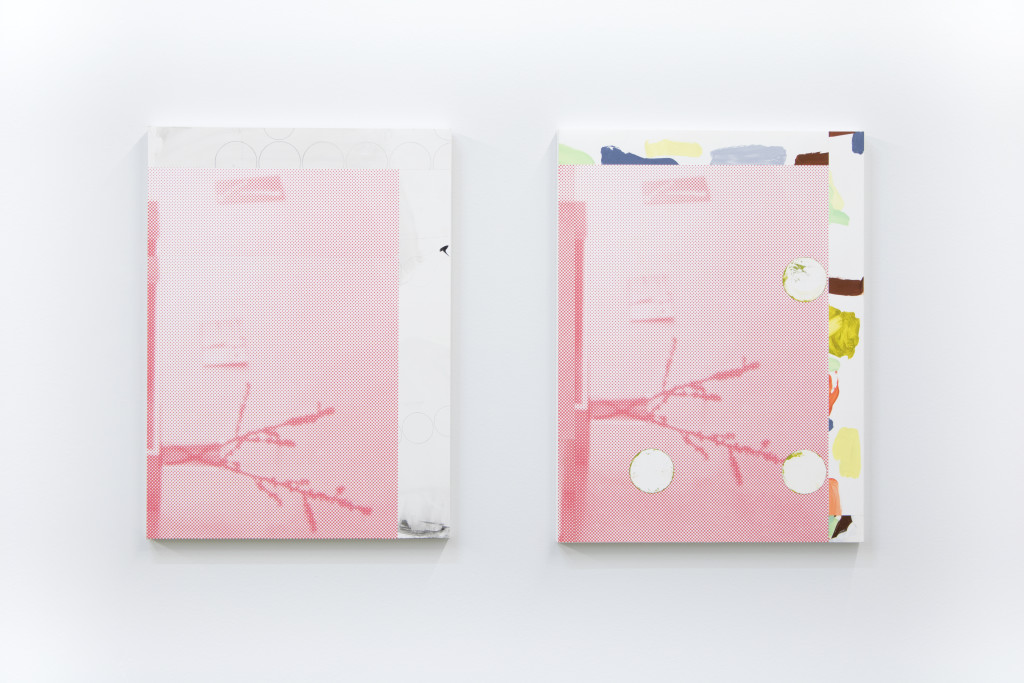
RC: I think there is a switch that happens, when you start to see paintings as objects When you are an art handler, as I was, the painting stops being painting. It was a thing on the floor that had to be taken care of, or hung properly, or stored. Then, it becomes difficult to paint if the painting is not an object.
DD: Yes, an object that has to be maintained, cared for, stored, presented. At some point I realized I had less of a desire to be the caretaker of a life-time’s worth of inventory. I began thinking about the ephemerality of the work I was doing and started working with more informal materials. Fragments of past pieces; cut-offs from older prints; found material.
RL: Are you economical?
DD: I do not think it is so much about that, but I do call these new works Scavengers because much of the material from which they’re made came from pieces of older prints that I still had in excess.
RL: Where does the image comes from?
DD: The photograph in these pink prints comes from a photo I took in the lobby of Le Corbusier’s, Unite’ de Habitation, or the “Corbusier Haus Berlin” the apartment building that he designed for Berlin and Marseille. I took the photos directly from other photos that were posted in the lobby of the building. They were images of model apartments at the time. I liked them because they were so haunting and dark and depressing, totally East German…I love that you couldn’t really see what some of the objects were in the space or on the walls. They were pictures of some sort. And I was really interested in that too.
RL: You are saying that these things flow in your studio. What brought you to work with that photograph originally?
DD: That is a good question. I knew the photographs would resonate on some level. Partly it was because the represented an ideal of some sort at the time, an ideal kind of utopian space, that suggested a kind of utopian democratic situation. But they were not, they were oppressive. So, I knew there was something. In some of the images you could see a figure behind some kind of frosted glass, which I thought was haunting. Everything about these photos was fantastic. If you ever go there, the lobby is the best part of that building because it is really beautifully designed, clearly somebody curated that wall. Somebody made a decision to place these things, and I don’t think it was actually a place where people lived so it was more of a model apartment or a stage, which ties into this whole thing about organizing and presenting and an awareness that someone would actively stage a thing.
RC: Do you have people in the back of your head that you are in a conversation with?
DD: Because my practice has shifted so much from being the entire focus of my life, and getting kind of burnt out from that, I now just have this more relaxed relationship to the work that I make. The anxiety and stress that came from self-imposed pressures and ambitions that may or may not have been realized, was replaced with more interest in just making really good work. I am still trying to produce things and to show that work, but I think I can look at my practice and say, “Finally, here. I did it once maybe I can do it again.” This piece, I really feel like that it got to a place that I’m really happy with. So, I try to figure out what it is that work that I recognize a sense or resolution or clarity. But your question was, are their people in the back of my head? I don’t know. There are so many people doing so many different things, that there isn’t a specific person. Lately, there are new developments and ideas that I want to pursue. I’m thinking a lot about the stability of the picture support—both literally and figuratively. Taking the picture off the frame but somehow keeping it on the frame. That idea of slippage, the displacement of picture is something I’m thinking about recently. How this might become manifest within the language and structures of painting. Somehow wrapping it around and shifting it over, and then trying to fold them back together. I don’t know if that makes any sense. You can see that the picture is kind of slipping off. That interests me as a project for the next paintings.
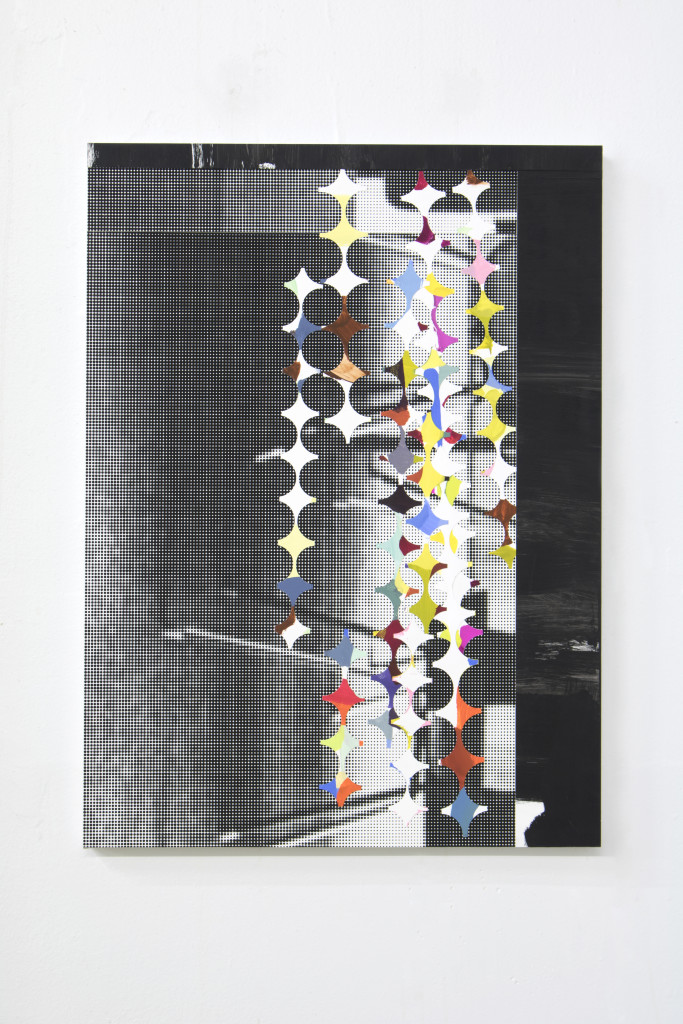
RL: Exactly, your work has a kind of consistency or preoccupation with the margins.
DD: I think the margins act as the entry points and the parameters of the work. There is an awareness of boundaries with the margin that is a powerful tool for a painter. In these recent paintings, that margin is a partial framing device that suggests foregrounding that helps push back the adjacent elements.
RC: And there’s a stability of balance that I wonder if you fight, push? I can imagine your hand is going to make a composition a certain way, your eye and your hand is going to inform the composition in a way that you know is balanced, I wonder if you’re incrementally pushing that…
DD: That is exactly what I am talking about, that sort of thing, that margin thing. It is a simple device to suggest an obstruction, barrier or window frame and that the photo image might then appear to exist behind it. But clearly, in that piece, it is fluctuating; it’s not sitting comfortably in front or behind. Early on in my career I was painting drapery and used it as a practical and conceptual device, that I worked with to obscure, hide and envelope. I was painting the drapery in a tromp l’oeil kind of a way. Later I would mount the canvas so I could literally cut through the painted image to reveal other visual elements. The holes provided a different kind illusion of 2-D reverting to 3-D and back again. The framing definitely worked off of that strategy. But it is also the idea that the picture is slipping off of that rectangle, it may be drifting away. For some reason that was interesting to me even then, I’ve got to figure out a way to develop that more. The idea of subverting the stability of traditional painting while holding it together.
RC: Yes, it is oppressive in a sense. Because I cannot, as much as I try to do it—even in my last show at Efrain Lopez gallery, it is by a millimeter. I would just sit there and be moving and looking…and then I would be like “ok that’s perfect.” But my whole thought was to get away from the images I had been making for years.
DD: Did they remain sort of two-dimensional? Or were they like more frontal, the sculpture or more three-dimensional? What about your recent stuff?
RC: Now I am working on a photography project. That show at Efrain Lopez capitulated an end point of this number of years of trying to do. Now I am waiting for it to transcend itself, rather than me transcend it.
DD: Exactly, let’s hope the work does the work for us.
RL: I feel like there is a sense in the crisis of painting, and I talk about the crisis in painting in the best way possible, because I really enjoy it. There is this unbelievable gap between the concern of pictorial plane, composition, foreground background, and then the materiality of painting as an object, it being material, sculptural, and installation work. Then painting has to address both things at the same time. It is really difficult, and I enjoy seeing what happens within that.
DD: I think this issue of illusion and pictorial space, acknowledging it and denying it, there are many artists interested in these themes. It’s seems to be about that kind of play that I certainly relate to. Asserting the use of a photo image immediately locks in some kind of illusion, that is a given. But by using the half-tone image, it subverts the reality of the photograph; making the image monochrome also plays into that subversion a bit. It is a constant shift of balance from one thing to another. I think it will always be interesting, it will always be a worthy conversation.
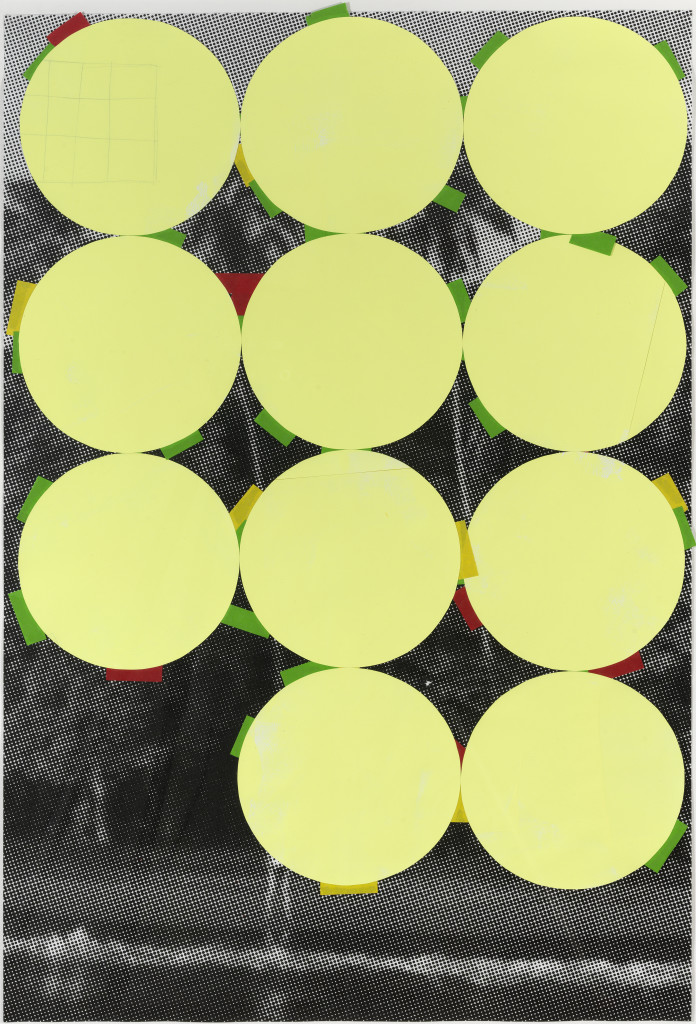
RC: I could be dead wrong but I imagine you being like “this object goes here” instead of “this photograph.” That was one of my things that I finally came to terms with and tried to eradicate with collage. I was using images, and I could give a shit about what it was. I was just a device to fulfill a composition.
DD: Yeah they work for me not because they are based on illusion or a different kind of representation; it was more the need for an indexical device that wouldn’t be painterly or material based, something to push against the material stuff and the photo-based half-tone was appropriate and clear. Yes I have these, and for sure it was both an object and a found thing but it was conveniently unlike all these brush marks and material/physical elements.
RC: How do you see work like Wade Guyton, in comparison to this?
DD: He solved a problem and still created an enigmatic object. Unfortunately, I think, the variations that resulted continued to solve a similar problem rather than a new one. I do have to say that now he’s moving in some very interesting and weird directions; the work seems to be less about visulality and process. He did those paintings that might still be up in New York, they were the front of the New York Times. I do not know how they are made or what it is like to experience them in person, but they were surprising. I am a sucker for his work in general. So yeah, I am sort of on board but I feel like he locked himself into a narrow zone for a while. I am also really interested in Christopher Wool’s work, and I feel like he compromises things a bit more interestingly than Wade Guyton does. Did you know that I showed a Wade Guyton piece in a past show? Yeah, there was a three-person exhibition I curated that included Cheryl Donegan and Tom Meacham. The show was part of year-long series of artist groupings I called “Kabinetts.” The series put different artists in relation to other artists. It was a real pleasure to have that work in the gallery and to spend time with a piece that spoke so directly to a possible direction for painting. It was also a little anxiety producing to have a work in my space that was quite important and valuable.
RC: I am curious about scale, it seems like you’re comfortable at a certain scale, do you ever go larger?
DD: Yes, they are different processes, but I have made some really big paintings. I have not really made big work using this process. Right now it is more pragmatic to work at this scale; so far I did not feel like it needed to be scaled up.
RC: It seems like what you were addressing earlier—it falling off the piece—could be addressed in a much larger scale, I think about your work in relation to Cy Twombly. He has a long horizontal piece at the Menil, I could see that being really addressed in terms of movement.
DD: That is interesting…one of the ideas about scale is partly related to the Yupo paper I am using. It is available in 60” or 30” rolls; the problem is the weight, it is really lightweight—so scaling up might make the work a little less stable than these smaller works. The first thing I thought about was to do a really long narrow piece, so you are thinking about the same thing, maybe the instability of the paperweight could create some interesting possibilities.
RC: Yeah, only I was thinking horizontally. The way some of the longer Twombly’s are like scrolls.
DD: I do not generally work horizontally for some reason.
RC: I hate it too; I can’t do it.
RL: It seems that your work is guided by restrictions or parameters that you intentionally try to subvert to loosen or free up something. Would you agree?
DD: Because I am always balancing the gallery, teaching, and the studio, my practice has become a bit fractured. Right now, it is about trying to make the work I can make within the set of conditions I have created for myself. It can be difficult when I am being pulled in several directions. When I started the gallery, I never expected it to become such a substantial and “real” thing, so I am always challenged by time and other commitments. With that in mind, I am really looking forward to the show at Triumph. I’m excited that you guys are interested in the work.
DOOR, the group exhibition of Dan Devening, Greg Bae, Jeff Prokash and Anna Shteynshleyger ran at Triumph Gallery from February 24 through March 26, 2017.
